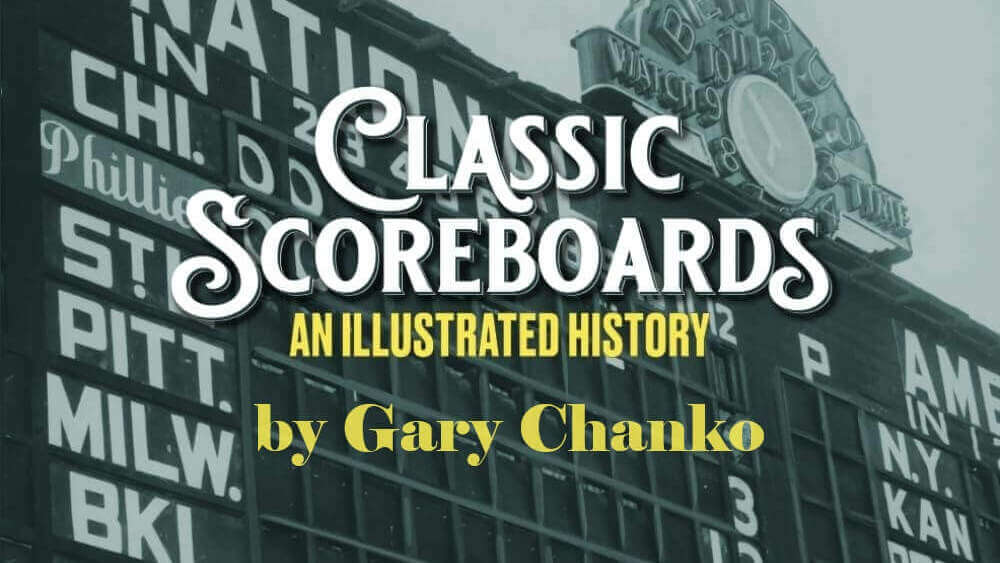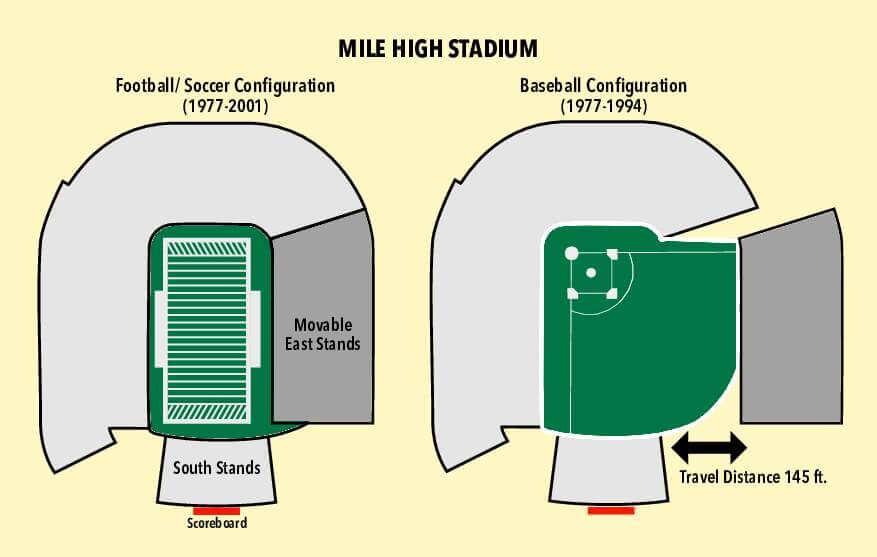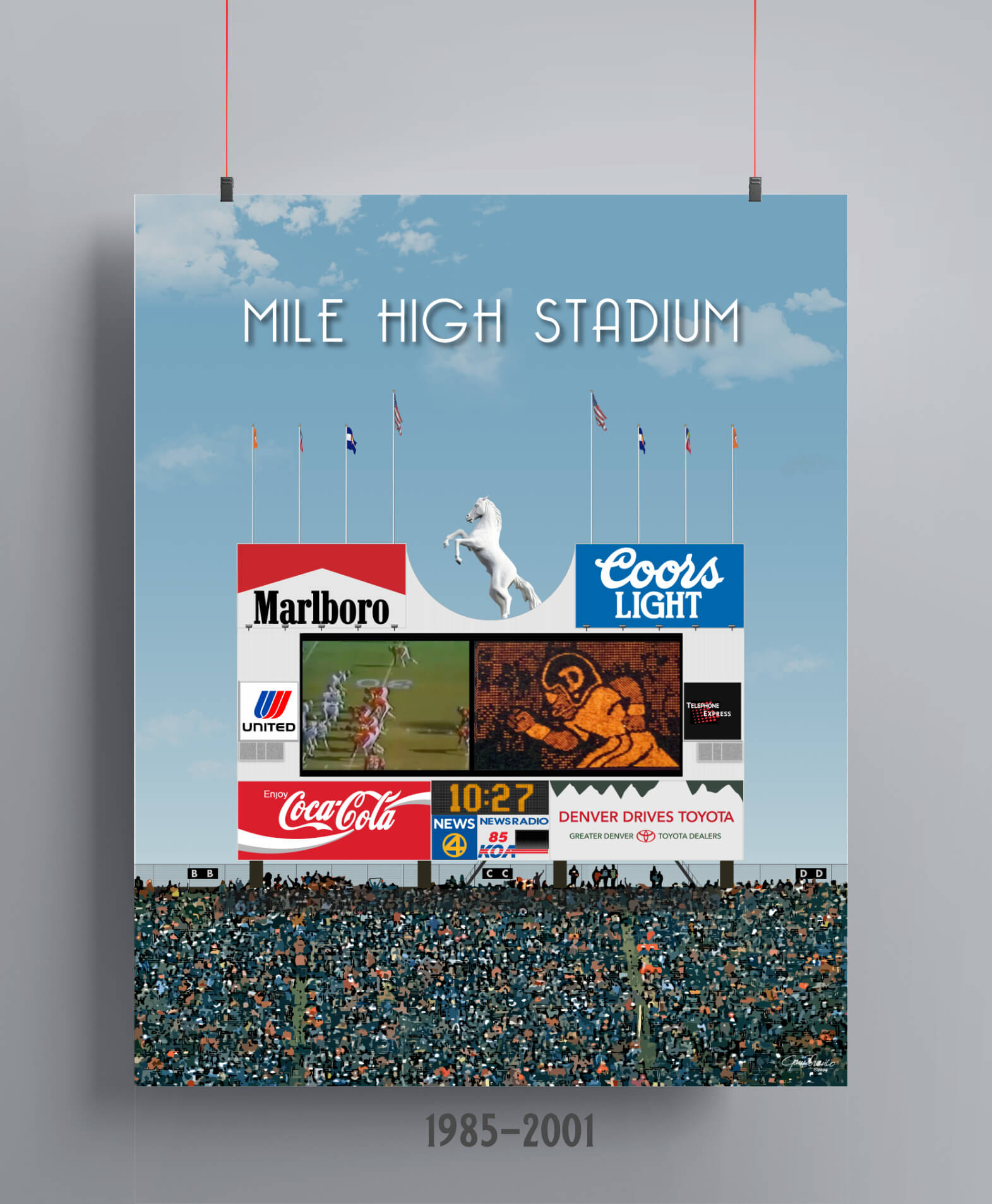
Long time readers will remember a time during the early-to-mid 2010s when I would frequently feature graphic depictions of baseball and football scoreboards, created by none other than long-time contributor, and friend, Gary Chanko.
Gary captured all of those scoreboards into a book, appropriately titled, Classic Scoreboards: An Illustrated History, which I had the pleasure of reviewing last last year. I’m pleased to announce that Gary has decided to continue creating scoreboards which were not contained in his wonderful book, which I’ll be featuring, once again, on Uni Watch.
by Gary Chanko
As I was finishing the final edits for my book, Classic Scoreboards, I considered adding a few more scoreboards. I had some ideas on an old to-do list, but creating new illustrations would have caused a delay in the publication of the book by a month or more, so I decided not to add any more content.
After the book was published, I received some suggestions from readers about new scoreboard illustrations. One of the suggestions was for Denver’s Mile High Stadium, a historic venue with a classic scoreboard that I had somehow missed in the past.
Mile High Stadium’s story began in 1948 as a minor league ballpark initially known as Bears Stadium. Back then, it was a modest 18,000-seat, a ballpark with uncovered grandstands. It was named for the Denver Bears (later Zephyrs) minor league baseball team.
During the next four decades, Bears Stadium underwent several major expansions bringing the final seating capacity to over 76,000. The first major expansion came in 1960 with the arrival of the Denver Broncos, a charter franchise of the American Football League (AFL).
The first major expansion came in 1960 by adding a new upper deck and temporary East stands (left field) to boost the capacity to 34,000. The scoreboard in left field towered above the temporary stands and served both baseball and football until another stadium expansion in the mid-1970s.
A New Name, a New Era
The AFL-NFL merger in the mid-1960s necessitated another stadium capacity increase that launched a transformation from a multipurpose venue to its ultimate identity. A capacity expansion to 50,000 was completed in 1968 and stadium ownership was transferred to the city of Denver. It was reborn as Mile High Stadium.
With the growing success of the Broncos in the 1970s the stadium quickly outgrew its capacity. By the end of the decade, the stadium was remade into a horseshoe configuration for football and capacity had grown to 75,000. The pictorial evolution of Mile High Stadium can be seen here.
The 1975 expansion produced the stadium’s historic south end zone scoreboard manufactured by Stewart-Warner. Throughout the 1960s and 70s, Stewart-Warner was a leading supplier of scoreboards. Mile High’s scoreboard technology appears to be identical to that installed in Three Rivers Stadium and Veterans Stadium during the same period. The new scoreboard also provided the showcase for the iconic Bronco mascot “Bucky.”
Bucky the Bronco
The saga of Bucky’s creation begins with the “King of the Cowboys,” Roy Rogers. Baby Boomers will remember him and his wife, Dale Evans, as popular Western stars in the 1950s and 60s. An equally popular part of the family was Roy’s Golden Palomino horse “Trigger,” (Bonus points if you can name Dale’s horse. Answer later).
The talented horse was memorized at the Roy Rogers-Dale Evans Museum in the mid-1970s with a fiberglass replica of Trigger as a rearing stallion. At that time, the Denver Bronco owners were planning for a major Mile High Stadium expansion, including a new state-of-the-art scoreboard. They reached an agreement with Rogers to produce a second copy of Trigger. That 27-foot-tall fiberglass copy would find a home atop the new scoreboard located above the stadium’s South Stands. The iconic Broncos mascot was named Bucky (selected from a local radio-sponsored contest) and remained a stadium landmark for twenty-five seasons.
In 2001, Mile High Stadium was replaced with the new home of the Broncos, which is now known as Empower Field. Bucky, the stadium’s mascot, was moved to a new home on the scoreboard. Recently, the scoreboard was upgraded, providing the perfect opportunity to refurbish Bucky and ensure that he remains a prominent feature in the future.
Dale Evans’ horse was “Buttermilk.”
The Innovative East Stands
Multipurpose Mile High Stadium hosted both baseball and football, so the different playing fields posed a problem for optimum seating configuration. The problem was solved during the late 1970s expansion using an innovative solution that enabled the stadium’s east stands (left field for baseball) to move in for football and out for baseball. The Mile High Stadium Configuration diagram describes the process. The technical details of the operation are explained here. Interestingly, the East Stands also had a third configuration available for soccer, but it was never used.

The Notorious South stands
In the late 1950s, the capacity of Bears Stadium was expanded to attract a major league team to Denver. Temporary East Stands were added along with an 8,000-seat bleacher section in right field, which eventually became the infamous South Stands – known for its loud and passionate Bronco fans. This Sports Illustrated article delves into the legend of the South Stands and its devoted fans.
First of Denver’s Bronco buck Coin
Mile High’s scoreboard was wrapped with both national and local advertisers. The First of Denver Bank was a major Bronco sponsor for a decade or longer. Their “First of Denver” ad, with a rampaging ram, was prominent along the scoreboard bottom from 1975 to 1980. During that period, each season the bank issued a Bronco Buck coin that listed the Broncos schedule on one side.
The Mile High Monument
Mile High Stadium was dismantled after the 2001 season, but the cherished symbol of Denver’s sporting heritage lives on. Mile High Monument is a small-scale replica of the original Mile High, including a mini version of the scoreboard with Bucky. This outdoor museum is located in a parking area just north of the current Empower Field.
The Scoreboard Illustrations
The evolution of the Mile High Stadium’s historic South Stands scoreboard is shown in two illustrations. Dates are best estimates based on a review of Broncos Video Yearbooks.
Mile High Stadium 1975-84 shows the scoreboard as it appeared from its inception in 1975 to about the mid-1980s. It depicts the final minute of the AFC Division Championship win against the Steelers on December 24, 1977.

Mile High Stadium 1985-2001 displays the changes that were implemented at the start of the 1985 season. The scoreboard was repainted white, new sponsors were added and On each side of Bucky, the flags of the USA, the State of Colorado, the City of Denver, and the Broncos were flown.

The scoreboard is divided into two sections, with the live video display occupying the left side. In the early 1970s, Stewart-Warner introduced their “Telescreen” video display technology, an early predecessor to Mitsubishi Electric’s Diamond Vision. It is likely Mile High’s scoreboard display used this technology (Further research is required to confirm this).
Just wanted to say I got Gary’s book for Christmas and loved every page of it.
My dad was a huge Raiders fan so I thought the real name of Mile High was “That Damned Place” until I was 7.
I can never see too many pieces on stadia with movable stands and movable roofs. Being able to reposition an enormous chunk of architecture over and over is a fascinating subject, and I appreciate the ingenuity that facilitates such a task. Was Shea Stadium the first? Or am I overlooking something obvious?
It looks like Pittsburgh’s Igloo came a couple of years before Shea.
The water bearing system has always fascinated me personally. Who knows if Camden Yards would have happened if more multipurpose stadia had done that instead of donut/octorad designs?
Good stuff! Would’ve also loved to see the scoreboard pre-1975, when it was on the east end of the stadium link
Roy Rodgers
That would be Roy Rogers.
I’m later to this party than I wanted to be, but as a lifelong Denver Broncos fan, I loved every word, image, and link in this story. Thanks, Gary, for putting this great trip down Memory Lane together! And thanks, Phil, for providing Gary a platform to share his great work with us!